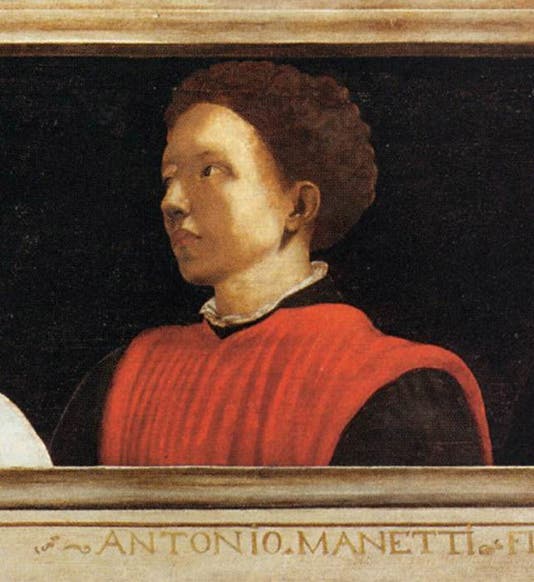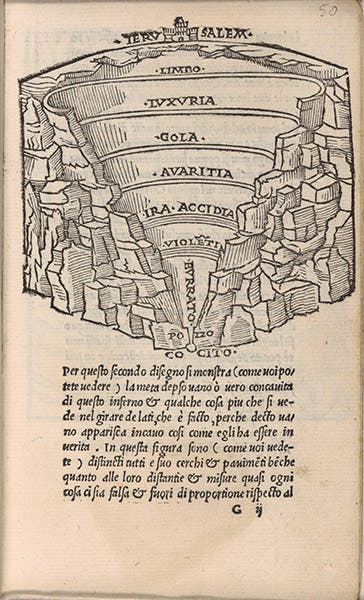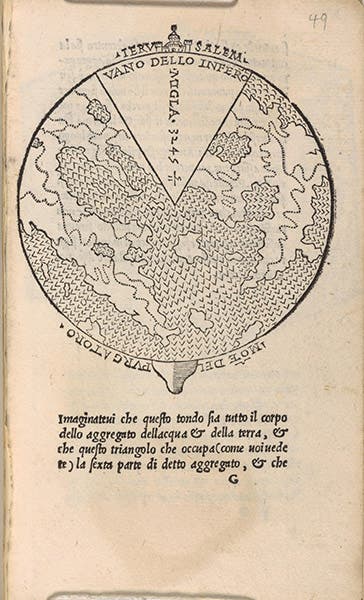Scientist of the Day - Antonio Manetti
Antonio Manetti, an Italian Renaissance mathematician, architect, and literary figure, was born July 6, 1423. We write about Manetti mainly to solve a mystery – that of the fifth man in a painting in the Louvre called (by modern art historians) Five Famous Men (first image). It is a small painting, with five portraits lined up in a row on a panel, the figures identified on the frame below. It used to be thought to be a work of Paolo Uccello, but now it is assigned to some unknown late 15th-century Florentine artist. If it looks at all familiar, it might be because we have shown it twice before in this series of posts. The figure on the far left is Giotto di Bondone, and we showed both the entire painting and a detail in our post on Giotto. The figure at the far right is the architect and inventor of linear perspective, Filippo Brunelleschi, and we showed the painting once more, again with a detail, in our post on Brunelleschi. The figure second from the left is the mathematician and painter Paolo Uccello, and third from the left is the great reviver of free-standing cast bronze sculpture, Donatello, and we will write about both of these at some future time, since both have connections to Renaissance mathematics and technology. But who is the fifth man, next to Brunelleschi, identified as Antonio Manetti? Most people who have taken a course on Renaissance art history will recognize Giotto, Brunelleschi, Paolo Uccello, and Donatello. Very few will remember Manetti, if they have ever heard of him at all. Today we fill in the blank.
Manetti is known primarily as the biographer of Brunelleschi. His book was not just a life of Brunelleschi – many before had written "lives" of their contemporaries, in the manner of the ancient Roman Plutarch, collections of stories along with lists of achievements, but seldom set into any kind of historical framework. Manetti wrote a biography the way we now write biographies, reading all the surviving documents, interviewing people who knew Brunelleschi or his work, using his own experience as an architect to explain Brunelleschi’s technical achievements. It was Manetti who made the case for a new Renaissance architectural style that began with Brunelleschi, rejecting Gothic and embracing Greek techniques and styles of building. Since Manetti lived for fifty years after Brunelleschi died, he was able to show the influence of Brunelleschi in subsequent Florentine architecture. This new kind of biography soon supplanted the Plutarchian-style of biography, and set the stage for the Lives of the Most Excellent Painters, by Giorgio Vasari, in the 16th century.
Manetti's other notable achievement was to delineate the architecture of Hell, as described in Dante's Inferno. Anyone who tackled the Inferno in a college lit class remembers that you needed more than Virgil as a guide as you tried to follow Dante's progress through the circles of Hell, from Limbo on down to the tomb of Lucifer. There may have been pictorial guides before those of Manetti – I am hardly a Dante scholar - but I could immediately appreciate those of Manetti. He worked them out sometime in the later decades of his life – he died in 1497 – and they were first printed as woodcuts in a posthumous work of 1506. I show just two of the seven, from a copy in the Cornell University Library. The first (third image) shows Limbo and the first four circles of Hell (lust, gluttony, greed, wrath), with the other five circles combined into two below. The second (fourth image) shows the location of hell as a cone of circles directly under Jerusalem and extending down to the center of the Earth You may see all seven woodcuts on Wikimedia commons with this search.
I do not know as I have convinced you that Manetti belongs with Giotto, Uccello, Donatello, and Brunelleschi as the fifth of the Five Famous Men of Florence. I have certainly not convinced myself. But at least now we know who he is. Perhaps he was included in the panel because he was a good friend of, or was admired by, the artist, whoever that artist might have been. It gives art historians yet another reason to try to solve that mystery.
William B. Ashworth, Jr., Consultant for the History of Science, Linda Hall Library and Associate Professor emeritus, Department of History, University of Missouri-Kansas City. Comments or corrections are welcome; please direct to ashworthw@umkc.edu.








![Using an astrolabe to measure the depth of a well, woodcut in Elucidatio fabricae vsusq[ue] astrolabii, by Johannes Stöffler, 1513 (Linda Hall Library)](https://assets-us-01.kc-usercontent.com:443/9dd25524-761a-000d-d79f-86a5086d4774/a998eb50-55d2-4a88-ace2-a50aa5fa86e7/Stoffler%201.jpg?w=210&h=210&auto=format&fit=crop)

